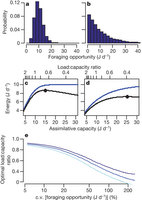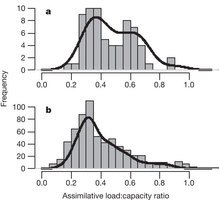摘要:在一个理想的世界里,食物供应将是有规律的和经常的,所以生物只需将正好够用的能力用于消化(消化是有代价的)。但面对不可预测的供应状况,生物则必须投入备用的消化能力,以便当有食物时它们能够消化之。Jonathan Armstrong 和Daniel Schindler对食物供应动态及生物对消化的投入进行了模拟,并收集了关于38种鱼类实际消化能力的数据 。他们发现,鱼类维持的消化能力要比它们实际需要的消化能力大近三倍。这种多余的消化能力表明,捕食者-猎物之间遭遇的不确定性要比人们一般所以为的大得多。
生物探索推荐英文论文摘要:
Excess digestive capacity in predators reflects a life of feast and famine
Abstract:
A central challenge for predators is achieving positive energy balance when prey are spatially and temporally heterogeneous. Ecological heterogeneity produces evolutionary trade-offs in the physiological design of predators; this is because the ability to capitalize on pulses of food abundance requires high capacity for food-processing, yet maintaining such capacity imposes energetic costs that are taxing during periods of food scarcity. Recent advances in physiology show that when variation in foraging opportunities is predictable, animals may adjust energetic trade-offs by rapidly modulating their digestive system to track variation in foraging opportunities. However, it is increasingly recognized that foraging opportunities for animals are unpredictable, which should favour animals that maintain a capacity for food-processing that exceeds average levels of consumption (loads). Despite this basic principle of quantitative evolutionary design, estimates of digestive load:capacity ratios in wild animals are virtually non-existent. Here we provide an extensive assessment of load:capacity ratios for the digestive systems of predators in the wild, compiling 639 estimates across 38 species of fish. We found that piscine predators typically maintain the physiological capacity to feed at daily rates 2–3 times higher than what they experience on average. A numerical simulation of the trade-off between food-processing capacity and metabolic cost suggests that the observed level of physiological opportunism is profitable only if predator–prey encounters, and thus predator energy budgets, are far more variable in nature than currently assumed.

Figure 1: Results from a simulation model exploring the energetic profitability of excess capacity for assimilation as a function of the daily variation in foraging opportunity.

Figure 2: Histograms showing bioenergetics estimates of integrated consumption rates in wild piscine predators, expressed as the assimilative load:capacity ratio.







